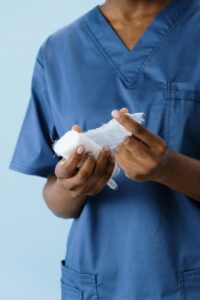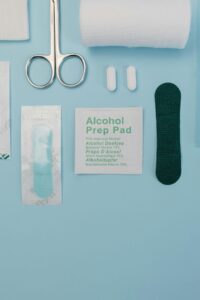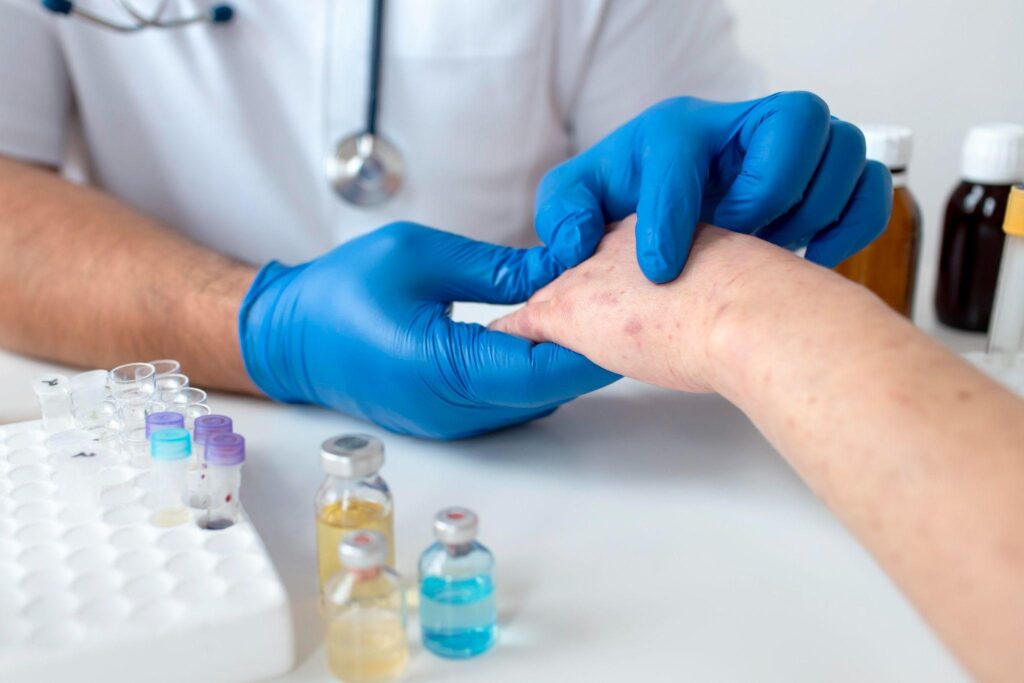Chronic wounds, particularly diabetic ulcers and pressure sores, are serious health concerns that can significantly affect a person’s quality of life. These types of wounds, unlike acute wounds, persist over a long period and do not heal on their own, making them difficult to manage.
This post will look at the common causes of chronic wounds, especially those linked to diabetes and immobility, and provide evidence-based strategies for chronic wound healing.
Understanding Chronic Wounds

A chronic wound is a wound that fails to heal in a timely and effective manner. The body typically goes through a series of stages to repair a wound: hemostasis, inflammation, proliferation, and remodeling. However, in the case of chronic wounds, this process is interrupted or delayed.
Several factors contribute to chronic wounds, including poor circulation, infection, and underlying health conditions. Among these, diabetes and immobility are two of the most common contributors.
Diabetic Ulcers
Diabetic foot ulcers are one of the most common types of chronic wounds seen in individuals with diabetes. High blood sugar levels over time can damage blood vessels and nerves, leading to poor circulation and decreased sensation in the feet. This can result in cuts, blisters, or other minor injuries that the person may not feel. Because of the poor circulation, these wounds do not heal easily, and they can become infected, leading to further complications.
According to the American Diabetes Association, approximately 15–25% of individuals with diabetes will develop a foot ulcer during their lifetime. Without proper care, these ulcers can lead to serious infections, amputations, and even death. Early detection and intervention are critical to preventing complications.
Pressure Sores
Pressure sores, also known as bedsores or decubitus ulcers, are another type of chronic wound. These occur when there is prolonged pressure on the skin, usually in areas where bones are close to the skin surface, such as the hips, heels, and elbows. This pressure reduces blood flow to the affected area, causing the tissue to become damaged and necrotic.
People who are bedridden, wheelchair-bound, or have limited mobility are particularly at risk for developing pressure sores. These wounds can start as red, irritated areas of skin and progress to deep ulcers if not managed properly.
Chronic Wound Healing: The Process and Challenges
Chronic wound healing is a complex process. For a wound to heal, several biological processes must occur in the proper sequence. These processes include:
- Inflammation: This is the body’s initial response to injury. It helps protect the body from infection and prepares the wound bed for healing.
- Proliferation: During this stage, new tissue forms to fill the wound. This includes the growth of new blood vessels and the development of collagen.
- Maturation: The final stage, during which the wound becomes stronger and more resilient as the tissue reorganizes and remodels.
In chronic wounds, these stages may be disrupted due to poor circulation, infection, or other factors, causing the wound to remain open for extended periods.
Clinical Approaches to Chronic Wound Healing

Proper medical treatment is crucial for promoting chronic wound healing. Several clinical strategies can be employed to help manage chronic wounds, especially diabetic ulcers and pressure sores.
1. Wound Cleaning and Debridement
Debridement is the process of removing dead tissue, dirt, and other debris from the wound to promote healing. This can be done using various methods, such as surgical, mechanical, or enzymatic debridement. By removing nonviable tissue, debridement helps to create a clean environment for new tissue growth. Clean wounds are less likely to become infected, and the healing process can proceed more effectively.
Debridement can be a painful procedure, so it is often done under local anesthesia or sedation. In some cases, debridement can be performed in a hospital or clinic setting, while in others, it may be done at home by a trained professional.
2. Infection Control
Infections can significantly delay wound healing and may lead to further complications. If a wound becomes infected, doctors may prescribe antibiotics or antifungal medications. In some cases, topical antiseptics may also be used to prevent infection. Wounds that show signs of infection, such as increased redness, warmth, or discharge, should be treated promptly to avoid serious complications, including sepsis.
For diabetic ulcers, controlling blood sugar levels is critical to minimizing the risk of infection. High blood sugar impairs the body’s ability to fight infections, so individuals with diabetes should closely monitor their blood sugar levels and follow their doctor’s recommendations.
3. Pressure Relief for Pressure Sores
For individuals with pressure sores, pressure relief is essential. This can be achieved by using special cushions, mattresses, or pads that reduce pressure on vulnerable areas of the body. Additionally, frequent repositioning can help prevent further damage to the skin. Repositioning should be done at least every two hours to reduce the risk of developing new pressure sores.
People who are bedridden or immobile may benefit from specialized pressure-relieving devices, such as air-fluidized beds or alternating pressure mattresses. These devices help distribute pressure evenly across the body and promote better blood flow.
4. Management of Blood Sugar Levels in Diabetic Patients
For individuals with diabetic ulcers, managing blood sugar levels is critical. High blood sugar levels impair the body’s ability to heal wounds and fight infection. By maintaining blood sugar levels within a normal range, the healing process can be significantly improved.
In addition to blood sugar management, diabetic patients should also focus on proper foot care. This includes daily foot inspections for cuts, blisters, or other injuries, as well as keeping the feet clean and dry. Proper footwear is essential to prevent pressure and friction on the feet, and diabetic patients should avoid walking barefoot to minimize the risk of injury.
5. Use of Advanced Dressings
There are various types of advanced wound dressings designed to promote chronic wound healing. These dressings maintain a moist wound environment, which has been shown to speed up the healing process. Some dressings also contain antimicrobial agents to prevent infection.
For example, hydrocolloid dressings are commonly used for pressure sores and diabetic ulcers because they help create a moist environment while also absorbing exudate. Additionally, silver-based dressings may be used for wounds that are at high risk of infection, as silver has antimicrobial properties.
Home Strategies for Chronic Wound Healing

In addition to clinical treatments, several home-based strategies can complement professional care and support chronic wound healing.
1. Nutrition
Proper nutrition plays a significant role in wound healing. Protein, vitamin C, and zinc are particularly important for tissue repair. Ensuring adequate intake of these nutrients can help improve the body’s ability to heal wounds. For individuals with diabetes, controlling carbohydrate intake is also important to maintain stable blood sugar levels.
2. Moisture and Hydration
Dry skin can make a wound worse, so keeping the skin around the wound hydrated is crucial. Applying a moisturizer around the wound can help maintain skin integrity and prevent further breakdown. However, the wound itself should be kept clean and dry according to the doctor’s recommendations.
3. Proper Foot Care for Diabetic Patients
For people with diabetes, daily foot care is essential to prevent diabetic foot ulcers. This includes inspecting the feet for cuts, blisters, or signs of infection, keeping the feet clean and dry, and wearing comfortable, properly fitting shoes to avoid pressure on certain areas.
4. Regular Repositioning for Bedridden Patients
For individuals who are immobile, it is crucial to change positions regularly to avoid pressure sores. Repositioning every two hours is generally recommended. Special mattresses and cushions can also help alleviate pressure points and improve comfort.
Secure Your Online Doctor’s Note From My Dr’s Note
Chronic wounds, especially diabetic ulcers and pressure sores, require careful management and intervention. Whether it’s through clinical treatments, such as infection control and debridement, or home strategies like proper nutrition and repositioning, the goal is always to promote healing.
If you are experiencing an illness that impacts your ability to work or attend school, obtaining an online doctor’s note might be necessary. At My Dr’s Note, we provide real doctors’ notes for work or school, and FMLA certification services to help you manage your health while maintaining your daily responsibilities.
Contact us today for a real doctor’s note online.


